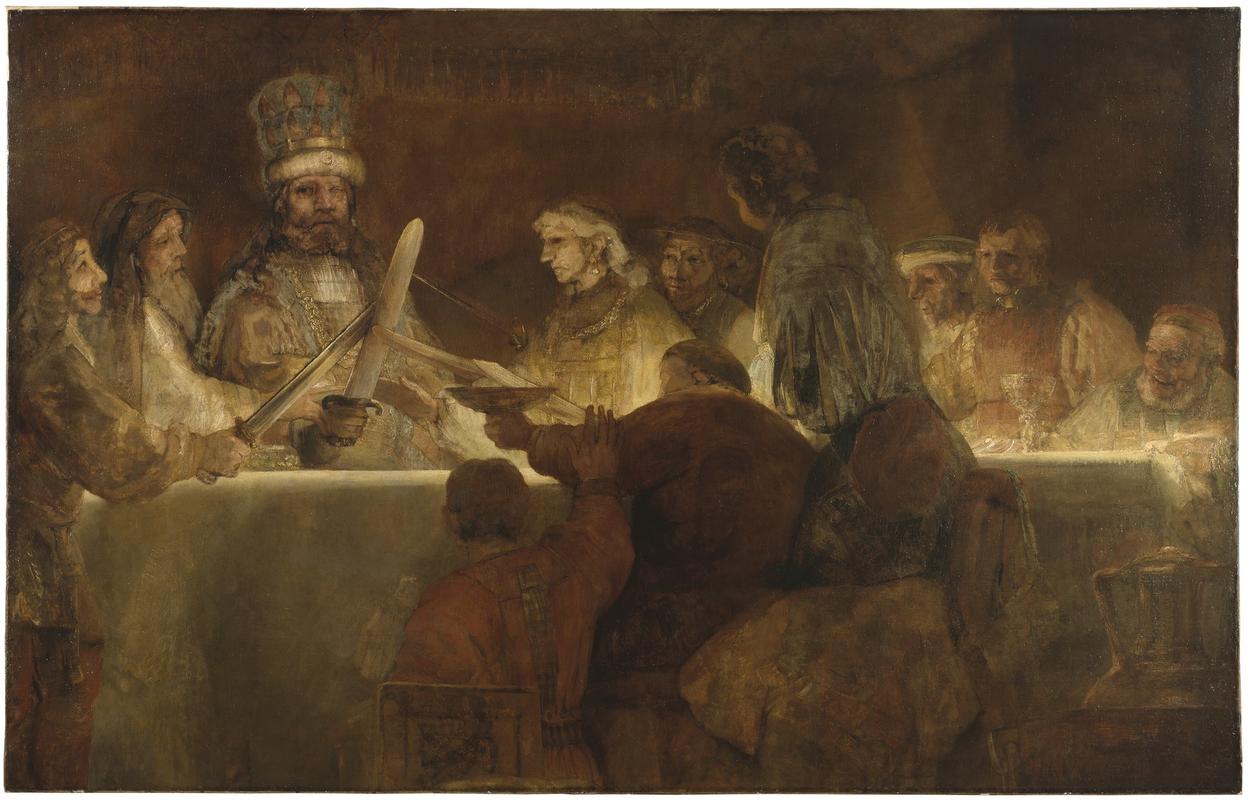More about The Conspiracy of the Batavians under Claudius Civilis

Contributor
Rembrandt van Rijn demonstrates genius The Conspiracy of Claudius Civilis by injecting it, through a variety of subtle and brilliant artistic techniques, with his unique and anti-authoritarian viewpoint.
This is a masterful example of the artist working within the system, taking up the directive of a local political authority on commission and giving the narrative his own interpretation. While his use of opaque light and free strokes are an influence on later abstraction in the work of Helen Frankenthaler and Claude Monet, the narrative history of this painting is much more thorough than most abstract works.
For a series of eight propaganda paintings in its Town Hall, Amsterdam was looking for a painting of a scene from the work of the Roman historian Tacitus, which shows the secret meeting of Claudius (also known as Julius) Civilis, of the indigenous Batavi people, getting drunk with a group of friends and forging an alliance to lead a local resistance to the brutal Roman empire. The commission fell to Rembrandt because of the unexpected death of an earlier painter the city had chosen for the job, a man named Flinck. Rembrandt was one of several painters to display in the series.
Rembrandt went back to Tacitus and found something funny: although the Town Hall wanted the artists to use the Batavian uprising to evoke the recent Dutch resistance to the Spanish empire under William of Orange, depicting the heroes as noble, intellectual, upper-crust revolutionaries, this image doesn't fit the original story. The Romans, obsessed not only with conquest and organized military violence but also with the sexual exploitation of poor people, had abducted those "of distinguished beauty (and many attain even in boyhood to a noble stature), whom they dragged off for infamous purposes." Motivated to defend his people from the indignities of the Romans, Civilis collected at one of the sacred groves, ostensibly for a banquet, the chiefs of the nation and the boldest spirits of the lower class. When he saw them warmed with the festivities of the night, he began by speaking of the renown and glory of their race, and then counted the wrongs and the oppressions which they endured, and all the other evils of slavery. "There is," he said, "no alliance, as once there was; we are treated as slaves. When does even a legate come among us, though he come only with a burdensome retinue and in all the haughtiness of power?"
Rembrandt was in a pinch. The narrative ordered by the patrons at Town Hall just didn't fit the spirit of the actual story. So, rather than making art to please his patrons, he made the art to speak his truth, the truth of the resistance of common people, and not the beautiful ones, to the excessive force of the Empire. It is unsurprising that Town Hall removed the painting, and its poetic display of a one-eyed leader and his ragtag posse, almost immediately, demanding a new version. Rembrandt cut the painting down, and never had the opportunity to realize the full vision of it as he displayed in his preliminary sketch, which shows a much wider perspective.
The art historian Kenneth Clark writes that Rembrandt was "as much in rebellion against the classical legacy of Rome," unlike the Town Hall authorities, who wanted to replicate the "greatness" of Rome by conquest, "as were Claudius Civilis and his friends." Clark connects the painting and its history to Rembrandt's affinity for Judaism, particularly its concept of justice in reincarnation, and posits that Rembrandt's connection with the spirit of the Torah, also dealing with the problem of Roman oppression, caused the Town Hall to reject the painting.
Sources
- Cavalli-Björkman, Görel. "A Source-Critical Comment on Roger de Robelin's The Conspiracy of the Batavians Under Claudius Civilis." Art Bulletin of Nationalmuseum Stockholm 20 (2013): 135-136.
- Clark, Kenneth. An Introduction to Rembrandt. New York: Harper & Row, 1978.
- Clark, Kenneth. "The Artist Grows Old." Daedalus (Winter 2006): 77-90.
- Kitson, Michael. Rembrandt. London: Phaidon, 1992.
- Manwell, Elizabeth, "Gender and Masculinity." In A Companion to Catullus, edited by Marilyn B. Skinner. Oxford: Blackwell, 2007.
- Moser, Benjamin. "Rembrandt—The Jewish Connection?" The New York Review of Books, Aug. 14, 2008, https://www.nybooks.com/articles/2008/08/14/rembrandtthe-jewish-connect….
- Tacitus. The Histories, vol. IV, line 14. WikiSource, https://en.m.wikisource.org/wiki/The_Histories_(Tacitus)/Book_4.
- Westermann, Mariët. Rembrandt. Phaidon Press, 2000.
Featured Content
Here is what Wikipedia says about The Conspiracy of Claudius Civilis
The Conspiracy of Claudius Civilis (Dutch: De samenzwering van de Bataven onder Claudius Civilis; Swedish: Batavernas trohetsed till Claudius Civilis) is an oil painting by the Dutch painter Rembrandt, c. 1661–62, which was originally the largest he ever painted, at about five by five metres in the shape of a lunette. The painting was commissioned by the Amsterdam city council for the Town Hall. After the work had been in place briefly, it was returned to Rembrandt, who may have never been paid. Rembrandt drastically cut down the painting to a quarter of the original size to be sold. It is the last secular history painting he finished.
The painting is on exhibition at Nationalmuseum in Stockholm, Sweden.
Check out the full Wikipedia article about The Conspiracy of Claudius Civilis












